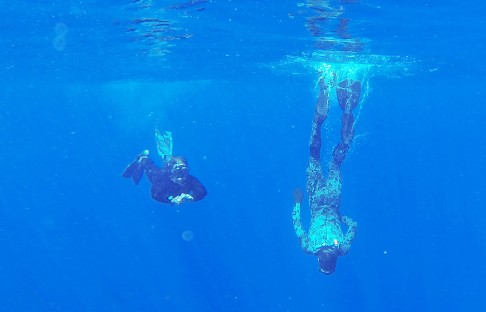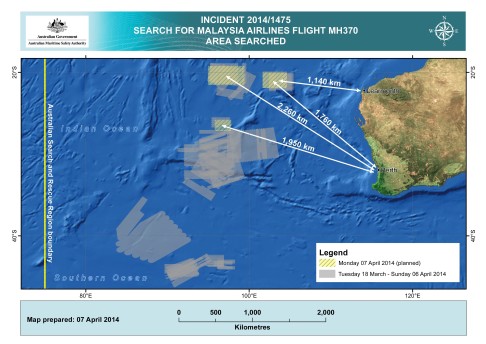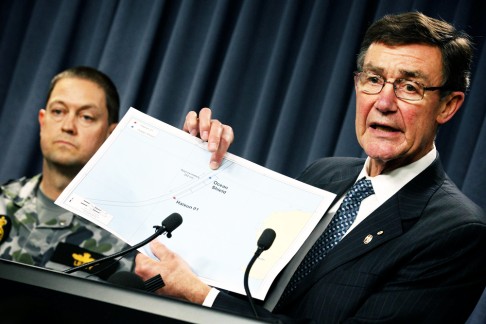An unmanned submarine that the Australian government said would be launched today to help search for missing flight MH370 will not be deployed until the search area has been further narrowed down, officials said today.
Angus Houston, head of the Australian agency coordinating the search, said the Bluefin 21 would only be put in the water when search teams had picked up more signals.
"It is a large area for a small submersible that has a very narrow field of search, and of course, it is literally crawling along the bottom of the ocean," he said.
"That’s why its so important to get another transmission and we need to continue until there’s absolutely no chance the device is still transmitting."
Australia's Acting prime Minister Warren Truss said earlier that the submarine would be put in the water close to where possible black box 'pings' were detected.
Once launched from the Australian navy's Ocean Shield ship, it will use sonar to create images of the seabed in an effort to locate any debris from the flight, which went missing a month ago today.
If any potential wreckage is discovered the sub will be fitted with a camera and sent back to photograph the scene.
Crews have so far had no luck in relocating the signals that were picked up at the weekend, Truss said.
"Today is another critical day as we try and reconnect with the signals that perhaps have been emanating from the black box flight recorder of the MH370," he said.
"The connections two days ago were obviously a time of great hope that there had been a significant breakthrough and it was disappointing that we were unable to repeat that experience yesterday."
“Everyone’s anxious about the life of the batteries on the black box flight recorders. Sometimes they go on for many, many weeks longer than they’re mandated to operate for — we hope that’ll be the case in this instance. But clearly there is an aura of urgency about the investigation.”
Finding the plane's two black boxes is crucial in unravelling what happened to the Malaysia Airlines jet after it vanished from radar screens on March 8.
The Ocean Shield, using a "towed pinger locator" detected underwater "signals" consistent with black box transmissions for more than two hours on Sunday, officials revealed yesterday.
Former Australian defence force chief Angus Houston, who is leading the Perth-based hunt, said the signals in the Indian Ocean suggested ships and planes were searching "very close to where we need to be".
But search teams are locked in a race against time, with batteries in the plane's two flight data recorders powerful enough to emit pings for only about a month.
Houston said the navy's Ocean Shield first detected the signal late on Saturday night, holding it for two hours and 20 minutes before it was lost.
After making a turn, it again detected a pulse, receiving it for 13 minutes. "On this occasion, two distinct pinger returns were audible," he said.
"Significantly, this would be consistent with transmissions from both the flight data recorder and the cockpit voice recorder."
Warning that it could take days to confirm whether they were black box signals, he added: "Clearly this is a most promising lead, and probably in the search so far, it's … the best information that we have had.
"We've got a visual indication on a screen and we've also got an audible signal - and the audible signal sounds to me just like an emergency locator beacon."
Malaysia's acting transport minister, Hishammuddin Hussein, said last night: "We are cautiously hopeful there will be a positive development in the next few days, if not hours."
The airliner's black boxes normally emit a frequency of 37.5 kilohertz, while both signals picked up by the Australian ship were 33.3 kilohertz, said US Navy Captain Mark Matthews.
However, officials contacted the manufacturer of the flight recorders and were told the frequency could drift near the end of their shelf lives.
News of the Australian discovery came as the British ship HMS Echo spent yesterday scouring the seas following reports that the crew of the Chinese Haixun 01 had detected brief signals using a device dangled over the side of the vessel, 555 kilometres away.
Twelve planes and 14 ships were yesterday searching three designated zones, one of which overlaps with the Ocean Shield's underwater search.
Last night the head of Malaysia Airlines, Ahmad Jauhari Yahya, again refused to be drawn on whether he would resign. He said: "I have work to do here."





No comments:
Post a Comment